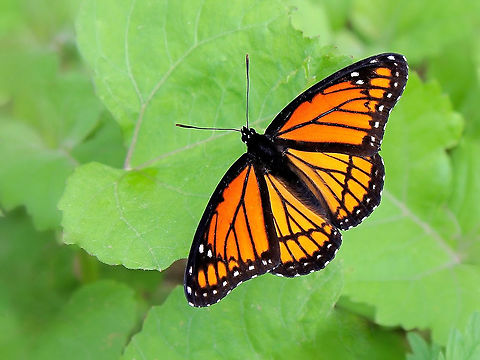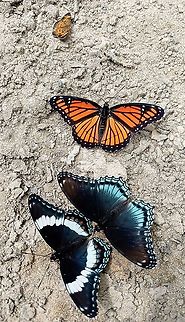
Appearance
Its wings feature an orange and black pattern, and over most of its range it is a Müllerian mimic with the monarch butterfly. The viceroy's wingspan is between 53 and 81 mm. It can be distinguished from the monarch by its smaller size and the postmedian black line that runs across the veins on the hindwing.In Florida, Georgia, and the American Southwest, viceroys share the pattern of the queen and in Mexico they share the pattern of the soldier . In all three areas, the local ''Danaus'' population mimic the coloration of the viceroy species. It was originally believed that the viceroy was a Batesian mimic of the three other species, and presumed edible or only mildly unpalatable to predators, but this has since proven not to be true.
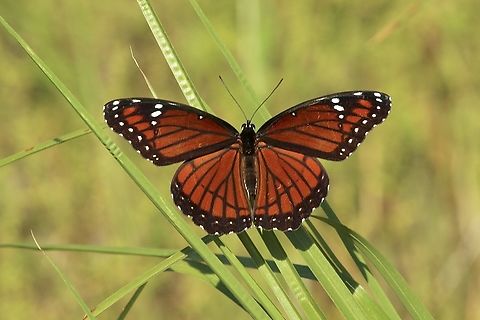
Food
The caterpillar feeds on trees in the willow family Salicaceae, including willows , and poplars and cottonwoods . The caterpillars sequester the salicylic acid in their bodies, which makes them bitter, and upsets predators' stomachs. As further protection, the caterpillars, as well as their chrysalis stage, resemble bird droppings.Adults are strictly diurnal, flying preferentially in the late morning and early afternoon. Adult viceroys nectar on milkweeds, thistles and other common flowers.
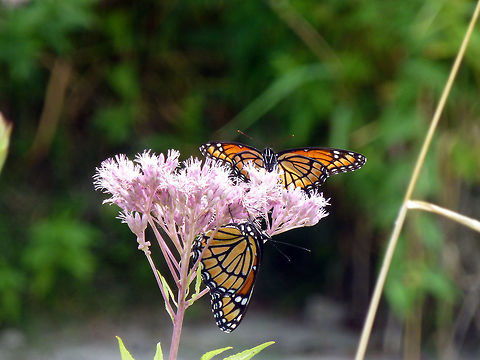
Defense
The viceroy's major defense against predators is purported to be mimicry. It had been long accepted that the viceroy practiced Batesian mimicry, with the monarch and the queen serving as models. Batesian mimicry is a type of defensive behavior in which a palatable species closely resembles unpalatable or toxic species to avoid predation. As such, the viceroy's wing color ranges from tawny orange in the north to dark mahogany in the south.Early experiments suggested that the viceroys use Batesian mimicry to defend themselves against predators. Birds that had not been exposed to monarchs, willingly ate viceroys, but those who had tasted the unpalatable monarch refused to touch the mimic. In addition, when given the choice between a mimic and non-mimic after being exposed to an unpalatable model, avian predators never ate the viceroy mimic.
It has been argued that selective pressures from predators have given rise to "model switching" in the viceroy, with each subspecies choosing to copy the color pattern of the locally dominant Danaine subspecies. When the monarch's breeding range overlaps with the viceroy, the viceroy will adopt the lighter shades of orange. Towards the south, the viceroy mostly displayed darker orange phenotypes in response to the larger population of queens. It is important to note that the differences between these two morphs is only the color of the wings and the line drawn through the viceroy's lower wings; other features, such as body size and wing-pattern elements, are identical.
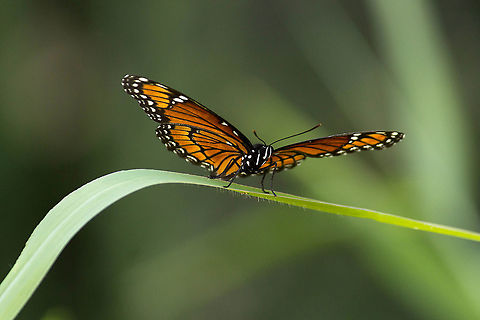
Evolution
Based on phylogenic evidence, it is known that mimicry in the North American admirals was a driver of speciation. An essential condition for the evolution of mimicry was the presence and abundance of unpalatable models. Mimetic evolution also involved direct selection with the model acting as a "starting block" for the mimic to evolve against. The drive behind this type of evolution must be predation. Eventually, the mimetic population undergoes phenotypic fixation, usually at a point where the wing pattern and colors of the mimic have reached the closest superficial resemblance of its model. As these processes continued, the subspecies divergences began occurring as the mimetic species expanded their geographical range and began mimicking other species of butterfly.Determining what part of the butterfly genome controls wing color and pattern is also a major component that must be taken into account when trying to understand the evolution of mimicry. Each individual stripe or spot on a wing has a distinct identity that can be traced from species to species within a family. A fascinating feature of pattern genetics is that the dramatic phenotypic changes are primarily due to small changes in the gene that determines the sizes and positions of pattern elements. This discovery is in accord with the principal theory for the evolution of mimicry. The theory proposes that initial mimicry is achieved by a single mutation that has a large effect on the phenotype, which immediately gives the organism some protection, and is then refined by so-called modifier genes with lesser phenotypic effects. Consequently, if the genes for wing pattern and color were normal functioning genes, a single mating would produce several phenyotypically different offspring, making the ability for mimicry to evolve very difficult.
This unique puzzle led to proposal of a possible supergene. A supergene is a tight cluster of loci that facilitate the co-segregation of adaptive variation, providing integrated control of complex adaptive phenotypes. Different genomic rearrangements have tightened the genetic linkage between different color and pattern loci with complete suppression of recombination in experimental crosses in a 400,000 base section containing at least 18 genes. This single supergene locus controls differences in a complex phenotype like wing coloration that can involve modifications of wing pattern, shape, and body color. Mimetic patterns have high fitness correlated to locally abundant wing patterns and low fitness when the offspring have recombinant, non-mimetic phenotypes. This tight-linked area of wing pattern genes explains how mimetic phenotypes are not broken up during recombination during sexual reproduction.
Color warnings in viceroy butterflies have been shaped by natural selection in an evolutionary relationship between prey and predator.
References:
Some text fragments are auto parsed from Wikipedia.
